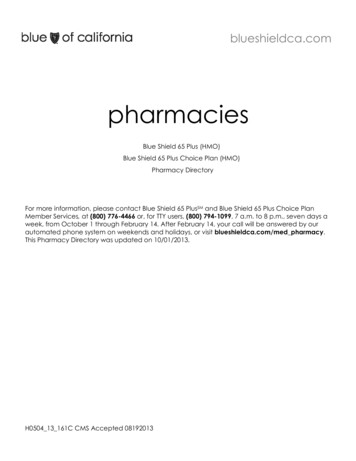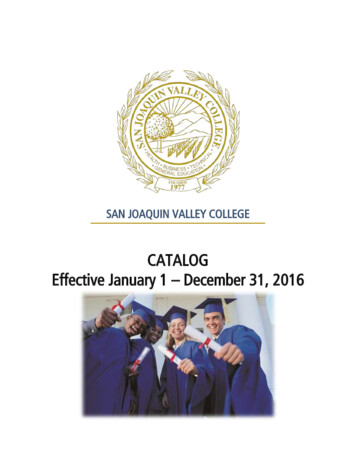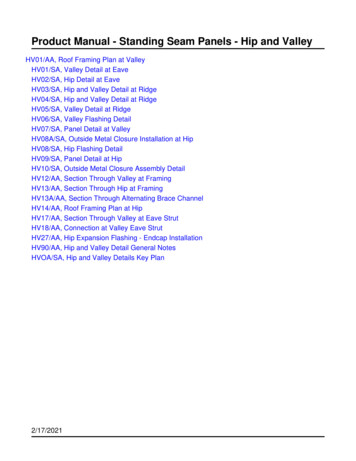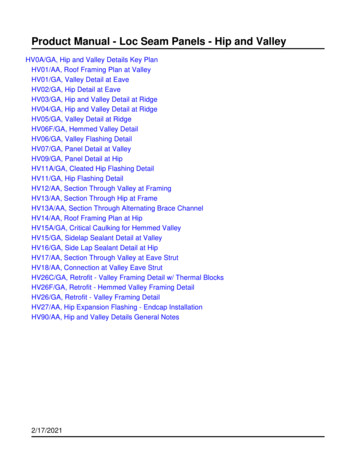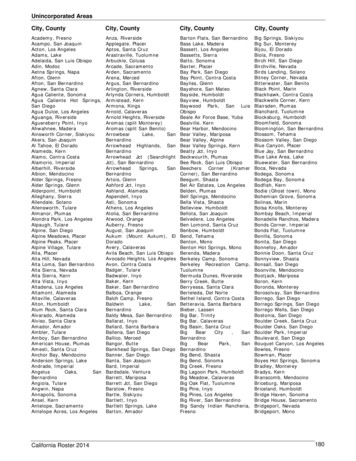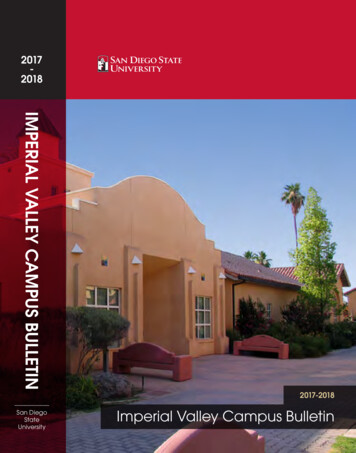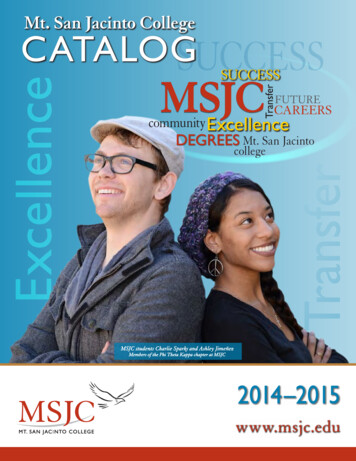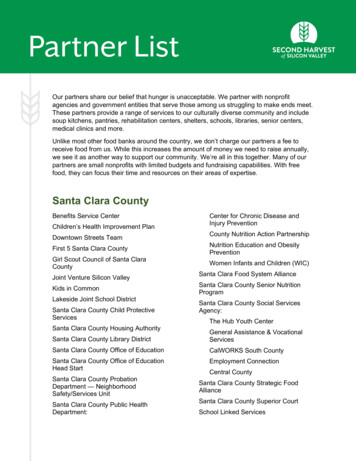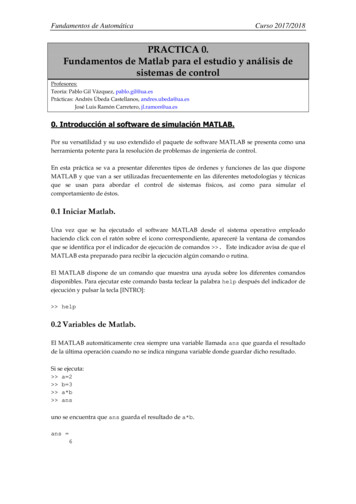
Transcription
California High School SAN RAMON VALLEY Dougherty Valley High School San Ramon Valley High School UNIFIED SCHOOL DISTRICTHIGH SCHOOL COURSE CATALOG9 -12 GRADE2012-2013THTH Monte Vista High School i
SCHOOL INFORMATIONCalifornia High School9870 Broadmoor DriveSan Ramon, CA 94583Website: www.calhigh.netRegistrar: Eileen WallDougherty Valley High School10550 Albion RoadSan Ramon, CA 94582Website: www.dvhigh.netRegistrar: Nancy AinsworthMonte Vista High School3131 Stone Valley RoadDanville, CA 94526Website: www.mvhigh.orgRegistrar: Cathy WilkinsSan Ramon Valley High School501 Danville Blvd.Danville, CA 94526Website: www.srvhs.netRegistrar: Barbara MurrayDel Amigo High School189 Del Amigo RoadDanville, CA 9452Website: www.dahs.srvusd.netVenture School10540 Albion RoadSan Ramon, CA 94582Website: www.venture.srvusd.netSan Ramon Valley Unified School DistrictEducational Services699 Old Orchard DriveDanville, CA 94526www.srvusd.netii
ALTERNATIVE HIGH SCHOOLSDEL AMIGO HIGH SCHOOL189 Del Amigo RoadDanville, CA 94526Website: www.dahs.srvusd.netDel Amigo is a continuation high school that benefits students needing more individualizedacademic and personal support. Small class sizes, daily attention from advisory teachers, anda low counselor-to-student ratio mean that no student is left behind or “lost” in the crowd of alarge campus. Most courses are NCP (non-college-preparatory). However, students maytake Cyber High courses (CP) on campus or concurrently enroll in Community Collegeclasses. Many students choose off-campus employment after school hours. Students maygraduate with a regular diploma from “Del Amigo High School” or return to their home highschool for graduation, provided they have accrued sufficient credits.VENTURE SCHOOL10540 Albion RoadSan Ramon, CA 94582Website: www.venture.srvusd.netVenture School offers both college preparatory and non-college preparatory courses throughthe means of independent study. The flexibility afforded this mode of instruction allows highschool students the flexibility to pursue other interests such as: Community college courses (based on space availability)Early graduationPre-professional sportsCareer opportunities in theater, music, and the artsTravelCredit recoveryFor more information on courses, go to www.venture.srvusd.net and click on the course list.iii
TABLE OF CONTENTSHIGH SCHOOL GRADUATION REQUIREMENTS .ivHIGH SCHOOL AND COLLEGE ADMISSION REQUIREMENTS . 1CREATE YOUR FOUR YEAR PLAN . 2GLOSSARY OF TERMS . 3GUIDELINES FOR CHOOSING A COURSE . 3SOCIAL STUDIES . 4Social Studies Electives . 7ENGLISH . 9MATH . 14SCIENCE . 17Biological Science . 17Physical Science . 19WORLD LANGUAGE . 21VISUAL AND PERFORMING ARTS . 26Visual Arts. 26Performing Arts . 29Dance . 29Music (Instrumental And Vocal) . 30Theatre Arts . 33CTE/ELECTIVES/NON-DEPARTMENTAL . 34PHYSICAL EDUCATION . 42SPECIAL EDUCATION . 45NCAA REQUIREMENTS . 46iv
High School Graduation RequirementsHistory/Social SciencesWorld Geography, World History, US History, American Government and Economics35 CreditsEnglish40 CreditsMathematicsMinimum requirement-must complete Algebra 1 or equivalent20 CreditsScience20 Credits10 credits of Life Science10 credits of Physical ScienceWorld Languages/Visual & Performing Arts/Voc/Career Tech & Applied Art10 credits in TWO of the above THREE areas20 CreditsPhysical EducationAll 9th graders must participate in P.E. for 10 creditsRemaining 10 credits can be obtained in 10-12th gradesHealth20 CreditsAdditional credits80 CreditsTOTAL CREDITS FOR GRADUATION5 Credits240 CreditsReturn to Table of Contentsv
High School and College Admission RequirementsSubjectRequirements(A-G)High School GraduationRequirementsSocial Studies(A)(35 credits)World GeographyWorld History 1/2US History 1/2Gov't/Econ2 years:1 yr. World History1 yr. US Historyor1 yr. World History1 sem. Gov't1 sem US History2 years:1 yr. World History1 yr. US Historyor1 yr. World History1 sem. Gov't1 sem US HistoryEnglish(B)4 yrs. (40 credits)4 yrs. CP (40 credits)4 yrs. CP (40 credits)Math(C)2 yrs (20 credits)Algebra 1GeometryAlgebra 24th year recommendedAlgebra 1GeometryAlgebra 24th year recommendedScience(D)2 yrs (20 credits)1 yr. Physical and1yr. Life Science2 years of lab science (e.g.,Biology, Chemistry, Physics,A &P)2 years of lab science 3rd year recommended (e.g., Biology, Chemistry,Physics, A &P)World Language(E)Visual/Perf. Arts(F)Cal State University(20 Credits) required from 2 yrs of the same languageany two fieldsSee World Lang.1 yr.Career Tech ED/ See World Lang.Applied ArtsHealth1 sem (5 credits)Physical Education 2 yrs (20 credits)Electives(G)(80 Credits)Total Credits240 CreditsTest Requirements Pass the California HighSchool Exit Exam(CAHSEE)University of California2 yrs of the same language 3rd year recommended1 yr.NoneNoneNoneNoneNoneNone1 year (2 semesters) ofadditional college prepcoursesGrade of C or higher in allcollege prep courses1 year (2 semesters) of additional college prep coursesSAT Reasoning Test or ACTAssessmentACT Assessment plus Writing or SAT Reasoning Test .Grade of C or higher in all college prep coursesReturn to Table of ContentsPage 1
Create Your Personal Four Year PlanGradeRequired t1stSemCareer Information and Plans2ndSemCareer Goal/Major:Math9Science/ElectiveSupporting Activities: (9-12)Physical Education60 crGeography/HealthCo-Curricular Activities:ElectiveElectiveSummer Plan:EnglishTotal Credits to Date: of 60Career Goal/Major:Math10120 crWorld History 2/3CAHSEE Scores:Physical or Life ScienceELA MathPhysical EducationElective/LanguageCo-Curricular Activities:ElectiveSummer Plan:11180 crTotal Credits to Date: of 120EnglishCareer Goal/Major:U.S. History 1/2PSAT /Physical or Life ScienceSAT I / /Math/ElectiveSAT II / /Elective/LanguageACT /ElectiveCo-Curricular Activities:ElectiveSummer Plan:12240 crTotal Credits to Date: of 180EnglishCareer Goal/Major:Amer. Govt./EconomicsColleges applied to:Physical or LifeScience/ElectiveCo-Curricular Activities:Math/ElectiveCommunity Service:Physical Education/ElectiveElectiveElectivePost High School Goal: CAREER / JUNIOR COLLEGE / 4 YR COLLEGETotal Credits to Date: of 240Return to Table of ContentsPage 2
GLOSSARY OF TERMSAccelerated: An advanced high school level curriculum that does not result in a weighted grade (e.g., Accelerated Biology)Advanced Placement Program/Exams: The Advanced Placement (AP) Program is a program of college level coursesand exams for secondary school students. Over 90 percent of the colleges that most AP candidates attend give credit and/orAdvanced Placement to students whose AP Examination grades are considered acceptable.In the San Ramon Valley Unified School District we have courses in English, Math, Science, Social Studies, Art, WorldLanguages, Music and Computer Science that meet the criteria of college level work established by committees of collegeprofessors. The AP exams that are given each May contain both multiple choice questions and free response questions thatrequire essay writing, problem solving, etc. Each examination booklet is typically graded by four professors and teachers.Every examination receives an overall grade on a five point scale: 5 (extremely well qualified) to 1 (no recommendation). An APGrade Report is sent in early July to each student's home address, school and, if the student requested, to his or her college.Students must earn a score of at least 3 to be eligible to receive college credit.Advanced Placement and Honors: These are a more challenging and rigorous high school level curriculum that resultsin a weighted grade for students who earn a grade of “C” or higher (e.g., A 5.0, B 4.0)National Collegiate Athletic Association (NCAA): The NCAA certifies the academic and amateur credentials of allcollege-bound student-athletes who wish to compete in NCAA Division I or II athletics. All students must register with theNCAA Eligibility Center. Students must register at end of junior year and submit a final transcript upon graduation.Regional Occupation Program (ROP)The ROP, administered cooperatively by the San Ramon Valley Unified School District and the Contra Costa County Office ofEducation, provides school-to-career preparation classes for juniors, seniors, and students who are 16 years old or older.Classes are designed to help students learn about career choices, develop job skills, and gain skills useful in college. Mostclasses can be taken for one or two periods, and some include internships. Students earn elective credits, and some classes offertransferable college credits. Certificates of proficiency are awarded upon successful completion of performance objectives.Students are also eligible to take ROP classes located off-campus.Why is ROP Different?The emphasis of ROP courses is on career development. Students can use skills acquired in class to prepare for a career afterhigh school, gain experience towards future college majors, and receive skills that lead to jobs before, during and after college.Instruction is individualized, and training is ‘hands-on’ using state-of-the-art equipment. All classes incorporate employmentreadiness training, which is an integral part of career planning.How to Register:To register for ROP classes on your campus, see your counselor. To register for off-campus classes see your counselor and callthe ROP office at 942-3436. Complete course schedules are located in the counseling office and career center.Schools: All. This refers to all comprehensive high schools, including California High, Dougherty Valley High, Monte VistaHigh and San Ramon Valley High.CSU/UC: The course meets a CSU and UC requirement within the “A – G” subject range.NCP: Non-college preparatory course.GUIDELINES FOR CHOOSING A COURSE1. GRADUATION REQUIREMENTS. Carefully check the graduation requirements.2. COLLEGE ENTRANCE REQUIREMENTS. Look for courses required by many colleges and universities.3. CAREER PLANS. Look for courses that can help you prepare for possible career goals.4. YOUR INTERESTS. Check for courses that let you pursue your own personal interests.5. PARENT APPROVAL. Talk with your parents about your course choices.6. TEACHER RECOMMENDATION. Talk with your teachers about course choices and get their recommendations.7. NCAA REQUIREMENTS. See page 44.Return to Table of ContentsPage 3
SOCIAL STUDIESWorld Geography and CultureThis required semester-long 9th grade course constructs a foundation for 10th, 11th, and 12th grade social science curriculathrough the study of culture in a geographical context. Physical geography is organized in terms of location, place,environment, movement, and region. Cultural studies focus on understanding concepts that describe political, economicbeliefs, and social systems along with learning about present day ways of life around the world and their historicalbackgrounds. In addition, students will incorporate map work, globes, graphs, the internet, library resources and classdiscussions.CSU/UC: “a”School: AllAdvanced World Geography and CultureThis challenging and accelerated semester-long 9th grade course constructs a foundation for 10th, 11th, and 12th grade socialscience curricula through the study of culture in a geographical context. Physical geography is organized in terms of location,place, environment, movement, and region. Cultural studies focus on understanding the basic concepts that describe political,economic, social systems and belief systems, along with learning about present day ways of life around the world and theirhistorical backgrounds—including the study of ancient history and religions. Using the “five-circle culture model,” studentswill compare and contrast diverse major cultures that arose in the world due to specific geographical forces, and also seek todiscover the common elements found in all cultures, thereby developing a multi-cultural perspective. Skill developmentfocuses on critical thinking, researching, reading, writing, speaking, and vocabulary enrichment (Cultural Literacy). Studyskill development centers upon the use of the student interactive notebook thereby utilizing the “Cornell notes” format formore effective organization and retention. In addition, numerous oral discussions and active participation will be encouragedthrough the use of “Socratic seminars,” current event updates and a class mock trial simulation.Prerequisite: Passing score on qualifying examination.CSU/UC: “a”School: CHSWorld History I & IIThis required year long 10th grade course presents a narrative of world history from the roots of democracy through thepresent. The course traces the development of civilizations throughout the world. Themes include political change, economicdevelopment, the growth of science and technology, the effect of contact between cultures, and creativity in the arts. Skillemphasis will include reading, analysis, speaking, note-taking, writing and research.CSU/UC: “a”School: AllSDAIE US History 2/3(9-12) This class is designed to cover the same curriculum as other World History classes at California High School, but itutilizes techniques specially designed to help English Language Learners master important concepts. It will be rotated everyother year with SDAIE U. S. History. The time periods covered in the class is from the15th century to the present day. Someof the major topics covered are the Renaissance, the Protestant Reformation, the French Revolution, the Industrial Revolution,Imperialism, World War I, the Russian Revolution, World War II, Post-WWII Africa, Asia, and Latin America. We willfollow the 10th grade standards and benchmarks of the state of California as the basis of the key events and themes studies.Other significant events, social movements, philosophies, and national leaders from several countries will be discussed indepth. One of the goals of this class is to improve writing the “5 Paragraph” essay. Developing the ability to analyze andcompare historical documentation is also an area of emphasis in this class.CSU/UC: “a”School: DVHS (Alternating year)Page 4
AP European History(10–12)This course is a full year introductory college course that covers European history from 1450 to the present. Studentswill gain an understanding of geography and the chronology of the major events and trends of that time period. Instructionwill include the principal themes in modern European history, an ability to analyze historical evidence, and an ability toexpress historical understanding in writing. The course covers the cultural, political, and socio-economic history of Europe inpreparation for the AP exam. For sophomores, this class will replace World History 2/3. For upper classmen, this class will becounted as a Social Studies elective.Prerequisite: “B” or better in the prior AP Social Studies course, if applicable, or “A’s” in prior college prep Social Studies course andEnglish course, or successful completion of qualifying assessment.CSU/UC: “a”School: AllUnited States History I & IIThis 11th grade course is required for graduation. This is a survey course covering the major political, economic, social, andcultural developments of United States history.CSU/UC: “a”School: AllAP United States HistoryAll students interested in this course should sign-up for U.S. History. Following a possible placement assessment thecounselors may place students into U.S. History AP. This class is a challenging two-semester course that is meant to be theequivalent of a freshman college course. The content is comprised of a complete survey of American history from the age ofexploration to the present using multiple perspectives. Emphasis will be placed on critical and evaluative thinking skills, essaywriting, and interpretation of original historical documents.Prerequisite: “B” or better in the prior AP Social Studies course, if applicable, or “A’s” in prior college prep Social Studies course andEnglish course, or successful completion of qualifying assessment.CSU/UC: “a”School: AllAmerican StudiesThis 11th grade course is a college preparatory class that mirrors American literature with their historical context. This twoperiod class is taught by an English teacher and a U.S. History teacher. This class will enliven literature and history byshowing their connections. The U.S. History portion in the first semester is a survey course covering the major political,economic, social and cultural developments in the history of the United States, from the country’s founding through WorldWar I (1918). During the second semester, the course covers from the end of World War I to the present. The English 11portion is a course in which students will study traditional and contemporary works drawn from American Literature.Materials include novels, plays, short stories, essays, poetry and non-fiction. Student writing focuses on refining the thesisstatement and developing the skills necessary for multiple writing tasks as well as the examination of rhetorical techniques innonfiction writing. The course also includes grammar instruction and vocabulary development. Students will get credit forEnglish 11 and for U.S. History 1 and 2.CSU/UC: “a”CSU/UC: “b”School: CHSAmerican GovernmentThis 12th grade course will examine the major principles of the American political system. Particular attention will be paid tothe political decision making process employed by Federal, State and local government. Students will also analyze the majorinstitutions of the American political system, such as the Constitution, Presidency, Congress, Supreme Court, political parties,voting, elections, civil liberties and the media. Special emphasis will be placed on helping the student understand his/her rolewithin the American political system.CSU/UC: “a” or “g”School: ALLPage 5
AP American GovernmentThis course will examine the nature of the American political system and will be concerned with the development ofAmerican political culture over the past two hundred years. The principal processes and institutions through which thepolitical systems function will be studied in detail. Specific areas of study will include: 1) the context of American politics, 2)the political process, 3) major institutions of the national government, 4) civil liberties and civil rights, 5) the nature ofAmerican democracy. Students may take the AP Exam at the end of the course.Prerequisite: “B” or better in the prior AP Social Studies course, if applicable, or “A’s” in prior college prep Social Studies course andEnglish course, or successful completion of qualifying assessment.CSU/UC: “a” or “g”School: AllAmerican Government – NCPAmerican Government is required for graduation. In this non-college preparation class students will learn the basic structureand values of the United States Government and will study current issues. Emphasis will be on class work and participation aswell as current event study and analysis.Prerequisite: Counselor Recommendation OnlyNote: This course is not UC & CSU certified.School: SRVHSAP Government and Politics ComparativeThis is a college level course that requires substantial reading and writing and prepares students for the AP exam in May. Thecourse examines the major components of the political system and culture of the United States, including Federalism, the threebranches, political parties and pressure groups, etc. The study of the American political systems serves as the basis for thecomparison of other contemporary political systems including Britain, Russia, China, Iran, Mexico, and Nigeria. This coursemeets the American Government graduation requirement and is linked with English 12.CSU/UC: “a” or g”School: SRVHS, MVHS, DVHSEconomicsThis 12th grade course examines the principles of the American economic system. It includes a study of comparative economicsystems, economic policy-making and decision-making, and of economic issues on a personal, national and internationallevel. This course includes principles of micro and macroeconomics.CSU/UC: “g”School: AllAP Microeconomics(12th grade) AP Microeconomics is an eighteen (18) week study of basic economic concepts and principles, as well as thefundamental concepts and factors concerning individual decision makers, product and factor markets, the structure of firms,and the role of government within the economy. The main areas of concentration include basic economic concepts; the natureand functions of individual product markets including measures of elasticity and indifference curves; forms of competition inthe market which include perfect and imperfectly competitive firms and there corresponding models; the nature and functionof factor or resource markets including input and labor costs; and, the efficiency, equity, and the role of government in themarketplace. Students are expected not only to know the material but also to apply critical thinking skills to the units coveredin preparation for the AP Microeconomics ExamPrerequisite: “B” or better in the prior AP Social Studies course, if applicable, or “A’s” in prior college prep Social Studies course andAlgebra II, or successful completion of qualifying assessment.CSU/UC: “g”School: AllPage 6
AP Macroeconomics(12th grade) AP Macroeconomics is an eighteen (18) week study of aggregate economic concepts and principles, as well asthe fundamental concepts and factors concerning macroeconomic measurements, aggregate demand and supply, fiscal andmonetary policy, economic growth, and international economics. The main areas of concentration include basicmacroeconomic measurements and concepts; measuring GDP, national income, inflation/deflation/recession, economicgrowth, and unemployment; analyzing aggregate supply and demand models; analysis of fiscal and monetary policy;understanding the banking and Federal Reserve system; long-run applications of the aggregate models; and an examination ofinternational trade, exchange rates, balance of payments, and trade deficits. Students are expected not only to know thematerial but also to apply critical thinking skills to the units covered in preparation for the AP Macroeconomics Exam.Prerequisite: “B” or better in the prior AP Social Studies course, if applicable, or “A’s” in prior college prep Social Studies course andAlgebra II, or successful completion of qualifying assessment.CSU/UC: “g”School: CHS, DVHS, MVHSEconomics – NCPThe study of economics will include microeconomic—individual economic decisions, and macroeconomics—the aggregatenational economy including international economics and basic consumer economics. This course meets graduationrequirements.Note: This course is not UC & CSU certified.Prerequisite: Counselor recommendation onlySchool: SRHVSReturn to Table of ContentsSOCIAL STUDIES ELECTIVESLaw (Introduction to)(11-12) This course provides students with a basis for understanding the American political and legal systems, with a focus onlegal ideas and the legal process. Students participate in moot court and mock trials by assuming the roles of trial attorneysfor both the prosecution and defense, developing analytical and critical thinking skills as well as oral presentation andteamwork skills.CSU/UC: “g”School: MVHS, SRVHS-ROPAP Human Geography(11-12) The purpose of this course is to introduce qualified students to the systematic study of patterns and processes that haveshaped human understanding, use, and alteration of the Earth’s surface. Major content areas to be studied are as follows: thenature of perspectives of geography, population, cultural patterns and processes, political organization of space, agriculturaland rural land use, industrialization and economic development, and cities and urban land use. Students will employ spatialconcepts and landscape analysis to analyze human social organization and its environmental consequences.Prerequisite: Teacher recommendations and pass screening test.CSU/UC: “g”School: MVHSPsychology(11-12) This course focuses on personal growth and provides students a basic introduction to the field of psychology. Studentslearn to apply basic psychology concepts to themselves so they have a better understanding of who they are and how they canrelate better to those around them.CSU/UC: “g”School: DVHS, (CHS – Year long), SRVHS, MVHS (Grade 12)AP Psychology(11-12) This class will challenge the student to study psychology at the college level. You will learn about the latest researchfindings regarding the brain, the mind, and behavior. Units studied will include research methods, consciousness, sensationand perception, neuroanatomy, motivation and emotion, learning theory, mental illness, personality theory, development, etc.This course is designed for the accelerated student seeking college credit through the advanced placement test. It expected thatall students will take the AP exam in May.Prerequisites: “B” or better in Psychology, or 3.0 overall GPA, or meeting criteria on placement assessmentCSU/UC: “g’”School: CHS (Grade 12), SRVHS, DVHSPage 7
Roots of Rock Music (Semester)(10-12) This is a one-semester elective designed to introduce students to the rich musical heritage of our country and exploreUS History in the process. Starting with slavery, the course moves from the blues, to rhythm and blues, jazz, the birth of rockand roll, and the evolution of modern rock music. Units include the blues, rockabilly, jazz, surf and hot rod music, the folkscene, soul and Motown, the British invasion, psychedelic era, 70’s rock, punk rock, techno and hip hop. Via video, the text,supplementary reading, internet, local musicians and the music itself, this class surveys selected topics in US History.Historical themes will include civil rights, war and peace, social class propaganda, and protest. Please bring an open musicalmind to this class. Much of the music will be unfamiliar to many students. This class has a text, unit exams, projects, andabout one homework assignment per week. Optional field trips to music clubs in the Bay Area will also be offered.Prerequisite: Cumulative average of 3.0 or better and a C or better in World History or US History.CSU/UC: “g”School: SRVHSSociology(Grade 11–12) Whereas psychology emphasized the examination of individual behavior, sociology studies human society,social relations, and behavior in and among groups. This course will examine topics such as culture and social structure, theadolescent in society, and the criminal justice system. Also included will be the examination of social institutions such asmarriage and family and religion.CSU/UC: “g”School: CHS - Year, DVHS, MVHS (Grade 12)Honors Modern East Asian HistoryGrades 11-12 As the world becomes smaller, knowledge or non-western history becomes all the more important. This courseanalyzes the modern transformation of East Asia. Topics include: the conflict of Sino centrism and modern nationalism in theChinese revolution, the Japanese road to Pearl Harbor, and the significance of the Korean War in East Asia.Prerequisite: Completion of World History I-II with a grade of B or betterMeets UC and CSU “g” elective requirementSchool: CHSThe History of East Asia(10 -12) In this course students will, distinguish between western and eastern ‘deep culture’, analyze and interpret the majorevents of Chinese History, analyze and assess China’s post-war challenges to west and the United States in particular.CSU/UC: Pending ApprovalSchool: SRVHSVietnam Era(11-12) This course examines US involvement in Vietnam as well as the social and political times in which that conflict tookplace. Students will use readings, videos, music, guest speakers, classroom exercises and simulations to explore the roots ofthe
San Ramon, CA 94583 San Ramon, CA 94582 Website: www.calhigh.net Website: www.dvhigh.net Registrar: Eileen Wall Registrar: Nancy Ainsworth Monte Vista High School San Ramon Valley High School 3131 Stone Valley Road 501 Danville Blvd. Danville, CA 94526 Danville, CA 94526
